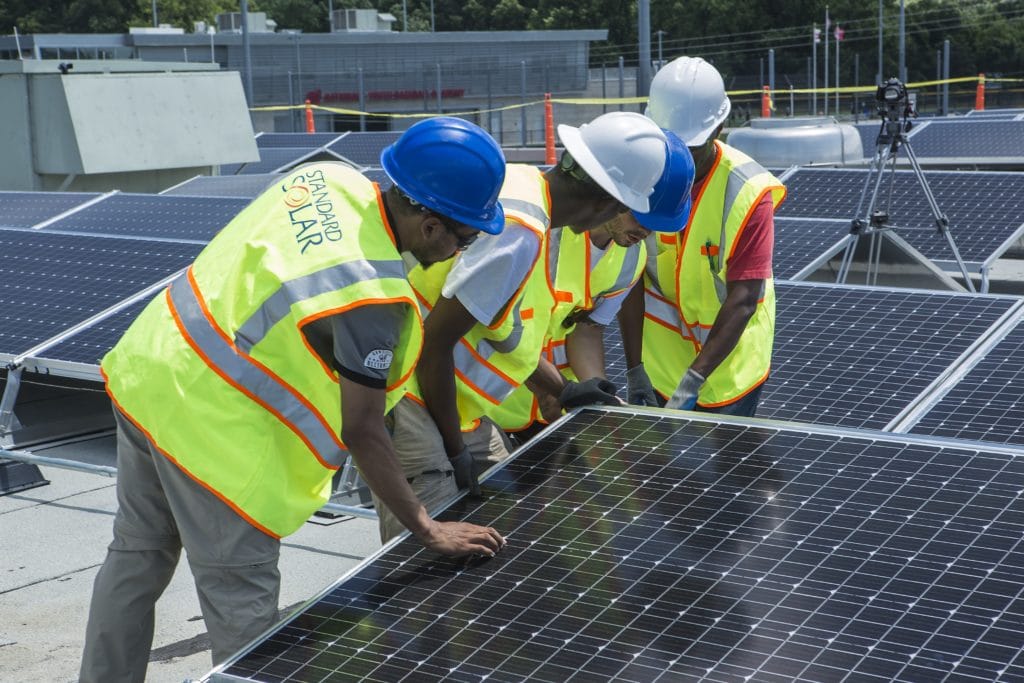Clean energy jobs paid 25% more than the national median in 2019, according to a new report, released by BW Research Partnership for Environmental Entrepreneurs (E2), the American Council on Renewable Energy, and the Clean Energy Leadership Institute.
According to the report, workers in renewable energy, energy efficiency, grid modernization and storage, clean fuels and clean vehicles earned a median hourly wage of $23.89 in 2019 compared with the national median wage of $19.14. The median hourly income in the solar industry was actually higher than the clean energy average, coming in at $24.48/hour, 31% higher than the national median.
It’s not just higher wages that clean energy industries have to offer, as the report also finds that the unionization rate across all clean energy occupations came in at 9%, which is slightly higher than the national private-sector average of 6%. This is not true of solar, however, with an average unionization rate of 4%, which is lower than the national private-sector average.
Additionally, clean energy jobs are more likely to come with health care and retirement benefits than the rest of the private sector.
“These jobs pay better, come with better benefits – and they’re also helping fight climate change and the growing economic costs that come with it,” said Bob Keefe, executive director at E2. “We need policies that ensure these good-paying jobs continue to grow and are available to every American in every state.”
On the state level
While clean energy jobs paid 25% more on the national level, there are certain states where clean energy jobs paid considerably more than the state median, which may be higher than the national median. Clean energy industries in six states paid wages at least 20% higher than the statewide median, led by California and Texas at 29.2% and 27.6% more than the state median, with Louisiana (24.9%), Massachusetts (23.2%) and New York (20.9%) rounding out the top-5.
As for which state paid its clean energy workers the highest average hourly salary, that designation goes to Massachusetts, where the median hourly clean energy income was $29.84. Massachusetts was followed by the District of Columbia ($27.56), California ($27.49), New York ($27.07) and Alaska ($25.75).
The comparison would not be complete without looking at how renewable generation jobs compare to jobs in fossil fuels. The report found that jobs in wind and solar combined for a $24.85 median hourly wage, while jobs in coal, natural gas and petroleum fuels registered at $24.37 an hour.
While that gap might not be as significant as some may hope, a key consideration is that clean energy industries employed about three times more workers than fossil fuels did in 2019 and that clean energy jobs are available in every state, regardless of geology or geography.
This content is protected by copyright and may not be reused. If you want to cooperate with us and would like to reuse some of our content, please contact: editors@pv-magazine.com.








By submitting this form you agree to pv magazine using your data for the purposes of publishing your comment.
Your personal data will only be disclosed or otherwise transmitted to third parties for the purposes of spam filtering or if this is necessary for technical maintenance of the website. Any other transfer to third parties will not take place unless this is justified on the basis of applicable data protection regulations or if pv magazine is legally obliged to do so.
You may revoke this consent at any time with effect for the future, in which case your personal data will be deleted immediately. Otherwise, your data will be deleted if pv magazine has processed your request or the purpose of data storage is fulfilled.
Further information on data privacy can be found in our Data Protection Policy.